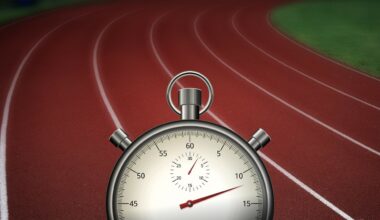The Role of Extrinsic and Intrinsic Motivation in Sports
Understanding motivation in sports is crucial for athletes striving for peak performance. Motivation drives athletes to train, push their limits and overcome obstacles. Two primary types of motivation exist: extrinsic and intrinsic. Extrinsic motivation stems from external rewards such as trophies, money, or recognition. These external factors can significantly influence an athlete’s performance level and commitment, especially in competitive environments. When athletes set their eyes on tangible rewards, they often boost their performance through the desire to earn accolades. Conversely, intrinsic motivation arises from deep within an individual. It includes a genuine love for the sport, personal satisfaction, and the joy of improvement. Athletes who are intrinsically motivated find fulfillment in their training, regardless of external rewards. This internal drive sustains their commitment even during challenging moments. Striking a balance between extrinsic and intrinsic motivations can amplify performance. For effective training regimens, understanding how these motivations work can help coaches and athletes devise strategic plans to optimize results. Harnessing both types leads to sustained engagement, allowing athletes to thrive both competitively and personally in their sporting journey.
Extrinsic motivation can significantly enhance an athlete’s performance when applied correctly. For example, societal recognition often serves as a powerful motivator in team sports. Players strive to be better not only for personal achievements but also for the pride of their team. Coaches often utilize rewards to spur performance improvements and maintain high morale. Recognizing individual or team accomplishments fosters an environment where athletes feel valued and driven. However, dependency on extrinsic motivators can lead to performance issues if athletes become overly focused on outcomes rather than their progress. This heavy reliance could result in anxiety, affecting their confidence levels. Conversely, intrinsic motivation plays a significant role in long-term success. Athletes who train for love and passion often demonstrate consistency, resilience, and mental fortitude. They are more likely to engage in deliberate practice, refining their skills regardless of immediate accolades. Research has shown that athletes motivated by the intrinsic joy of competition or self-improvement frequently achieve higher levels of satisfaction, even when outcomes are less favorable. Thus, a dual approach to motivation is essential for balanced and sustained athletic development, fostering both achievement and personal growth.
The Balance of Motivation
Achieving a balance between extrinsic and intrinsic motivations is crucial for athletes. Coaches must be adept at tailoring their motivational strategies to maximize performance. A nuanced approach involves recognizing each athlete’s unique motivators. Ongoing assessments and open conversations help identify what drives individual performances best. For instance, while some athletes might respond well to cash incentives or trophies, others could find inspiration in personal benchmarks. This recognition helps coaches design tailored training regimens that cater to these diverse needs. Establishing personal goals is another effective strategy for promoting intrinsic motivation. Athletes who set realistic yet challenging goals often experience higher satisfaction levels and develop personal ownership of their journey. These goals highlight progress rather than merely focusing on winning or losing. Moreover, fostering a positive environment is key to cultivating motivation. Supportive feedback encourages athletes to engage genuinely in their training. Similarly, peer support within teams can enhance feelings of camaraderie, tapping into intrinsic drive. Overall, creating an atmosphere where both intrinsic and extrinsic motivations coexist ensures athletes remain committed, focused, and resilient on their paths to success.
Moreover, the role of coaches cannot be understated when discussing motivational theory in sports. Coaches must understand the psychological aspects of motivation and adapt their strategies accordingly. Training sessions should embody an atmosphere conducive to learning and growth, allowing athletes to thrive. Coaches should facilitate a culture where athletes celebrate personal milestones and collective achievements simultaneously. By taking an integrated approach, coaches can harness the power of both motivation types. Workshops, team-building exercises, and individual meetings can help develop such strategies. Additionally, involving athletes in decision-making processes also reinforces their intrinsic motivation. They gain a sense of ownership, leading to improved performance and deeper commitment. Equally crucial is the ongoing evaluation of motivational strategies. Regular feedback sessions will shed light on the efficacy of current motivational approaches. Assessing athlete satisfaction and performance metrics provides insights into what works and what may require modification. Therefore, recognizing that motivation is a fluid concept, responsive to athletes’ needs, stands paramount. Adapting motivational styles over time ensures sustained enthusiasm and commitment throughout the sporting season, contributing positively to overall performance outcomes.
The Impact on Team Dynamics
The interplay of extrinsic and intrinsic motivation significantly influences team dynamics in sports. Team cohesion often flourishes in an environment where all members understand shared goals and aspirations. Team leaders, such as captains and coaches, play a vital role in fostering motivation and commitment. They need to implement strategies that encourage the collaborative pursuit of success while maintaining each athlete’s intrinsic drive. An example of this could be setting collective benchmarks alongside individual targets. This practice not only escalates team spirit but also underscores the importance of personal milestones within a larger context. Additionally, team-building activities that focus on collaboration contribute to intrinsic motivation by enhancing personal connections. Athletes who feel connected to their teammates often show increased intrinsic motivation, thereby strengthening overall performance. Moreover, developing a culture of appreciation manifests a positive climate for feedback and celebrates achievements, both big and small. This strategy maintains high morale, essential in competitive scenarios. Thus, managing both forms of motivation creates an environment where athletes can thrive collectively while still enjoying personal improvement, ensuring a holistic approach to sports engagements.
Accepting that motivation varies among individuals enhances sporting environments further. Athletes possess distinct backgrounds, experiences, and personal goals that shape their drive. Recognizing these differences calls for flexible approaches in motivation methods. For instance, some athletes might thrive under the pressure of public recognition, while others may prefer privacy in their achievements. Coaches should encourage open dialogues around these topics to cultivate understanding. Acknowledging individual preferences not only improves personal performance but also motivates collectively as teammates acclimatize to each other’s styles. This mutual respect fosters an inclusive environment where collaboration can flourish. Moreover, athletes from diverse cultural backgrounds bring unique perspectives to motivation, enriching team dynamics. Coaches must be sensitive to these variations, adapting motivational techniques to suit their athletes’ needs and cultural contexts. Providing personalized feedback and accommodations are practices that help every athlete feel valued. Overall, maintaining flexibility in motivational approaches can lead to improved engagement and heightened performance levels. Embracing this diversity ultimately cultivates an environment that fosters strong interpersonal relationships while maximizing individual and team successes across the board.
Conclusion
In conclusion, understanding and applying motivational theories is foundational for athletes aiming to improve performance and enjoyment in their sports. Striking a balance between intrinsic and extrinsic motivation is essential as it caters to personal and competitive ambitions. Coaches and participants alike can cultivate an environment where both forms thrive, thus enhancing athletic development. As highlighted, intrinsic motivation cultivates long-term commitment, while extrinsic motivation often drives immediate performance. Emphasizing personal growth alongside external rewards ensures athletes experience holistic development in their sporting pursuits. Therefore, sports organizations must prioritize understanding these motivational dynamics. This understanding helps create tailored strategies that resonate with each athlete’s aspirations. Ultimately, the goal remains to facilitate a thriving sporting experience where both commitment and enjoyment coexist harmoniously. Continuous evaluations can enhance these methods, making sports environments more dynamic and rewarding. Striving towards this goal positions both athletes and coaches for success, significantly improving overall satisfaction. Emphasizing both intrinsic and extrinsic motivators can help propel athletes forward in their endeavors. Achieving this balance fuels passion, engagement, and lasting joy in the pursuit of excellence in sports.
This is another paragraph with exactly 190 words…


